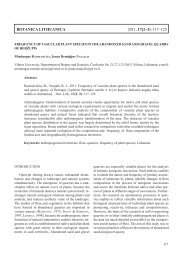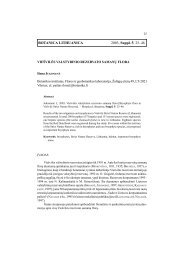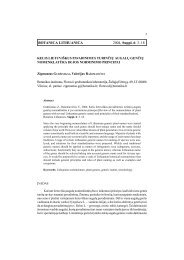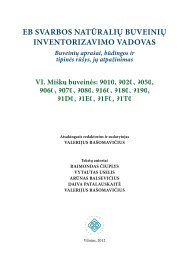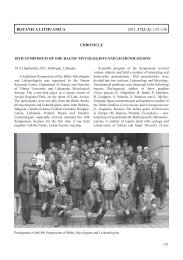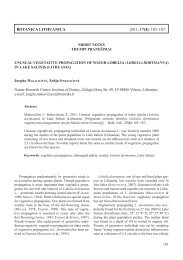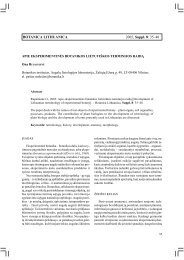FUNGI AND LICHENS IN THE BALTICS AND BEYOND XVIII ...
FUNGI AND LICHENS IN THE BALTICS AND BEYOND XVIII ...
FUNGI AND LICHENS IN THE BALTICS AND BEYOND XVIII ...
You also want an ePaper? Increase the reach of your titles
YUMPU automatically turns print PDFs into web optimized ePapers that Google loves.
wooden crosses (11). According to light requirement on anthropogenic substrates, most<br />
numerous are species, whose ecological amplitudes vary from averagely photophilous to<br />
extraphotophilous. These species accounted for 47 % of all taxa diagnosed in cemetery.<br />
During the research three indifferent to light requirement lichen species were identified:<br />
Lecanora albescens, Lecanora pulicaris, Caloplaca citrina. According to dependence on air<br />
humidity in cemetery dominate mesophilous species, and to a lesser extent – xerophilous<br />
lichens. Extraxerophilous indexes are characterized to Physconia perisidiosa and Physconia<br />
grisea species. During the research extrahigrophilous species were not found on<br />
anthropogenic substrates. According to eutrophication level averagely nitrophilous species are<br />
most numerous (50 % of all species). 2 rather rare, 4 rather common, 7 common and 21 very<br />
common lichen species were identified on anthropogenic substrates in Bernardinai cemetery.<br />
Two species from the rather rare category were reported – Aspicilia contorta ssp.<br />
hoffmanniana and Scoliciosporum umbrinum. It is planned to further study diversity of<br />
lichens of same age cemeteries in different parts of Lithuania.<br />
<strong>LICHENS</strong> OF CALCAREOUS ROCKS <strong>IN</strong> F<strong>IN</strong>L<strong>AND</strong><br />
J. PYKÄLÄ<br />
Finnish Environment Institute, Natural Environment Centre, P. O. Box 140, FI-00251<br />
Helsinki, Finland<br />
E-mail: juha.pykala@ymparisto.fi<br />
Calcareous rocks are threatened habitat types in Finland. The main threats are mining,<br />
building and forestry practices. Most calcareous rocks are very small, and thus vulnerable to<br />
changes in land use close to them. Lichens of calcareous rocks have been previously<br />
insufficiently known, although many rare species are known to occur only on calcareous<br />
rocks.<br />
During the years 2003–2008 120 calcareous rocks and lime quarries were studied in<br />
SW Finland. During the years 2009–2010 the study was expanded to cover all parts of<br />
Finland and additional 175 sites have been studied. The field work is continuing in 2011.<br />
The main aims are to study distribution and habitat characteristics of lichens of<br />
calcareous rocks and lime quarries in Finland, and to produce data for a more precise<br />
evaluation of their threat status. The results can be used to evaluate conservation and<br />
management needs of calcareous rocks and lime quarries and to develop management<br />
instructions for them.<br />
Over 13 000 specimens have been collected and up to date 137 lichens new to Finland<br />
have been found. The total number of calcicolous lichens is ca. 280 species, which is 16 % of<br />
all lichens occurring in Finland. The proportion of lichen species on calcareous rocks is more<br />
than 100-fold compared to the area of calcareous rocks.<br />
New localities have been found for most threatened lichens of calcareous rocks (e.g.<br />
Collema multipartitum, Nephroma helveticum, Peltigera retifoveata). Five species considered<br />
extinct from Finland have been refound (Caloplaca variabilis, Catapyrenium psoromoides,<br />
Coenogonium luteum, Gyalecta subclausa, Rinodina immersa). Numerous species of<br />
Verrucaria occur on calcareous rocks. 60 species new to Finland have been identified.<br />
However, a large number of species still remains unidentified.<br />
A strong south-north gradient occurs in the lichen flora of calcareous rocks. Many<br />
species occur only in southern or northern part of Finland. Many lichens on calcareous rocks<br />
are very rare. Small populations are typical to many species.<br />
Lime quarries are very important for many calcicolous lichens due to their large size.<br />
Several rare pioneer calcicolous lichens disperse rather effectively to lime quarries.



